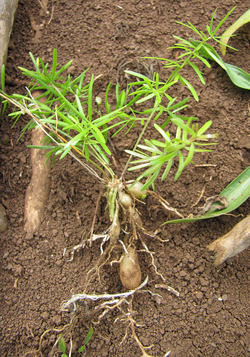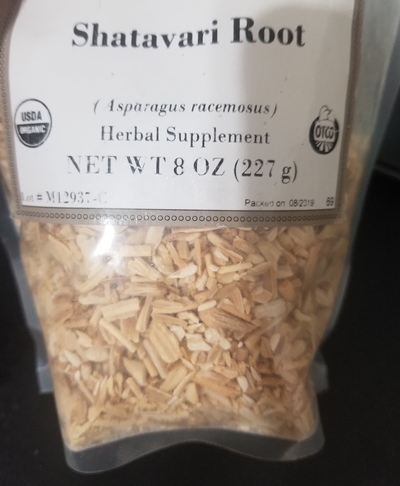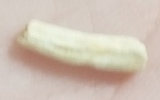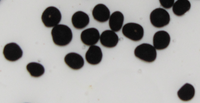Asparagus; Shatavari

Ayurvedic herb Shatavari (Asparagus racemosus) has a history of folklore for use in bust enhancement and health. Shatavari is often used to promote lactation for the purpose of nursing. This herb is also known as a general health tonic.
This passage describes the role of Asparagus in health and in breast enhancement. Shatavari's hormonal properties are described, and there's notes on potential use of this herb.
Etymology
The genus of Asparagus belongs to the plant family of Asparagaceae. Previously, asparagus was classified under the family Liliaceae.
Satamuli, Satawar, Satavari, Shatuli, Vrishya, Shatawari, Shatavari, Sheetaveerya and Rag Samsib are alternate names for Asparagus racemosus. Asparagus adscendens (Shweta musali), and Asparagus gonoclades are less popular for traditional medicinal use in India. Another well known species is common Asparagus (Asparagus officinalis).
Properties

Constituents of interest
Shatavari root contains shatavarins (I to X), which are saponins (steroidal glycosides). The most studied of these saponins, shatavarin IV (also known as asparanin B) is a spirostan which consists of sarasapogenin and a sugar molecule.
Shatavari root also contains the saponin phytoprogestins: diosgenin and sarsasapogenin.
Asparagus racemosus root contains 3βsterols: beta-sitosterol and stigmasterol.
Spirostans and sitosterols are Cholestanes.
Shatavari also contains kaempferol, a flavanol which is a phytoestrogen.
Asparagus species typically contain vitamins: A, B1, B2, B9, C and E. This genus contains the minerals: magnesium, calcium and iron.
Published studies
One study showed an ethanol extract of Shatavari to increase prolactin, which is consistent with its effects on the breast. Another study theorized if the antioxidant content of Asparagus racemosus root had a positive effect on reproductive health, including follicle development.
A study on Asparagus officinalis found that a water extract of its roots increased luteinizing hormone (LH), follicular stimulating hormone (FSH), gonadotropin releasing hormone (GnRH), progesterone, and estrogen.
Additional health benefit
A benefit of asparagus, is that its constituents, Shatavarins, have anti-cancerous properties.
Discussion
Shatavari seems to have a balanced effect on raising hormones. Asparagus' hormonal effects are likely circumstantial (as most herbs are) depending on the time of the menstrual cycle. Through literature, Satawar (asparagus) has similarities to suma. Anecdotal evidence suggests that Shatavari lacks estrogenic phytohormones which work directly on ERα which fenugreek has. These collections of both estrogenic and phytoprogestogenic herbs likely have these positive effects on increasing bodily hormones during luteal phase.
Use
Asparagus for breast enhancement


For purposes of breast enhancement, the root from many species of asparagus may substitute Shatavari. Asparagus has a small effect on breast tissue by itself. However, with the right combination of other herbs with varying properties, the potential for breast enlargement can be maximized.
The part of Asparagus that is used for herbal medicine is its tubers. Asparagus is better taken in solid form, either fresh, ground or dried, than through extracts. The reason for this is because un-extracted plants, contain fiber which is beneficial for health. The rhizome or root is soft, so it can be eaten.
Taking asparagus root by itself during proliferative phase is typically counter-productive to breast enhancement. In comparison, hops is a proven effective herb, that also is not effective during proliferative phase.

Asparagus root has successfully been used in place of fenugreek in the herb schedule on a few occasions for hip growth. Their use may be fitting for luteal phase when there's no swelling. Shatavari is better off as a supplement to fenugreek. Shatavari could indirectly cause breast growth, but through influencing the body's natural hormones. Shatavari needs to be used as a companion to fenugreek to cause breast growth, because its phytoestrogenic constituents vary.
shatavari01 is an obsolete specific herbal program that was based around shatavari (Asparagus) in theory for potential use. Use the herb program for luteal phase, where asparagus would be use in addition to fenugreek.
Asparagus or herbs with similar properties are in herb programs based on menstrual phases. There must be balance throughout phases, and combinations of herbs help the body acheive balance for health, breast growth and hip growth. It's important that menses is light and short. Also, preventing an excess of negative symptoms for menses helps set the balance for proliferative phase. Luteal phase uses a different combination of herbs than proliferative phase for symptoms. For a simplified herb schedule, where there's commonality of herb recommendations for symptoms such as swelling and signs of excess estrogen, use nonmenses. BCP01 is a composite page of pieces of different programs on birth control or IUD use.
Herb timing and combinations' success for breast enhancement relies on menstrual phases. Descriptions and pictures of results from herb combination use can be seen in programs. For more guidance, see guide, or hirsutism-topic.
Similar herbs
Shatavari (Asparagus), suma (Hebanthe), maca (Lepidium), Passionflower (Passiflora), kudzu (Pueraria) and fenugreek (Trigonella) contain both phyto-progestins and phyto-estrogens. Their properties likely vary, so they may require a different proportion or a different variation of companion herbs.
Fenugreek (Trigonella) has estrogenic compounds with effects on ERα, which Pueraria may also have. Other herbs which contain both phytoprogestins and phytoestrogens like Shatavari (asparagus) may lack this specific effect, as their estrogenic effect is limited to ERβ. These other herbs can supplement fenugreek or Pueraria.
Asparagus has similar hormone raising properties as fenugreek and suma. However, asparagus and possibly suma lack estrogenic phytohormones which are specific to the breasts. Shatavari appears to work directly on estrogen receptor ERβ instead of ERα
Precautions


There are different accounts on whether asparagus berries are edible, but it's better to avoid them. Berries of Asparagus curillus (and possibly of Asparagus berries in general) have abortifacient properties.
See precautions for more details of care to be taken with herb use. Proper nutrition is a consideration for health. Also, check for the latest blog updates about herb and hormone safety.
It is very important that menses be light and not prolonged.
If you have hirsutism, PCOS, hot-flashes, other signs of hormone imbalances, see estrogen-imbalance, and hirsutism program journals at hirusitism-topic before trying herbs.
Herb concentrates can be tens of times more potent by weight than herbs in solid form. This can easily lead to hormone imbalances. For this reason, concentrate extracts are not recommended for extended or excessive internal use, especially during fertility years. Concentrates shouldn't be used to overcome plateaus. Another issue with herbal extracts, is that they may not have the full range of properties of the herb. Essential oils are not recommended for breast enhancement. If opting to use herbal extracts, use food grade extracts, with no more than 1 drop at a time diluted in water.
More


For the latest herb programs and how to get started, see: guide. Pictures of breast enhancement can be seen in the program journals of Anon02, Anon08, Anon09, Bubblemelon and Jellie.
For resources on hips and butt enhancement, see: /appendix/hips-butt-enhancement and /appendix/kettlebell.
breast-endocrinology.pdf describes the science of breast development and endocrinology. It also describes symptoms related to hormone imbalances. Biology and hormone imbalances are excerpts from this ebook. breast-endocrinology.pdf uses a Creative Commons (CC BY-ND 4.0) license.
Breast.is blog
References:
- Asparagus racemosus--an update. https://www.ncbi.nlm.nih.gov/pubmed/14515032.
- Shatavarins (containing Shatavarin IV) with anticancer activity from the roots of Asparagus racemosus. https://www.ncbi.nlm.nih.gov/pmc/articles/PMC3523501/.
- Plant profile, phytochemistry and pharmacology of Asparagus racemosus (Shatavari): A review. https://www.ncbi.nlm.nih.gov/pmc/articles/PMC4027291/.
- A Double-Blind Randomized Clinical Trial for Evaluation of Galactogogue Activity of Asparagus racemosus Willd. https://www.ncbi.nlm.nih.gov/pmc/articles/PMC3869575/.
- Effects of aqueous extract from Asparagus officinalis L. roots on hypothalamic-pituitary-gonadal axis hormone levels and the number of ovarian follicles in adult rats. https://www.ncbi.nlm.nih.gov/pmc/articles/PMC4869160/.
- Chemical constituents of Asparagus. https://www.ncbi.nlm.nih.gov/pmc/articles/PMC3249924/.
- Comprehensive metabolic and transcriptomic profiling of various tissues provide insights for saponin biosynthesis in the medicinally important Asparagus racemosus. https://www.ncbi.nlm.nih.gov/pmc/articles/PMC6002474/.
- Impact of stress on female reproductive health disorders: Possible beneficial effects of shatavari (Asparagus racemosus). https://www.ncbi.nlm.nih.gov/pubmed/29635127.
- Furostanol saponin and diphenylpentendiol from the roots of Asparagus racemosus. https://www.ncbi.nlm.nih.gov/pubmed/22978214.
- A Double-Blind Randomized Clinical Trial for Evaluation of Galactogogue Activity of Asparagus racemosus Willd. https://www.ncbi.nlm.nih.gov/pmc/articles/PMC3869575/.
- . .
Etymology & Definitions:
- USDA: Asparagus classification profile. http://plants.usda.gov/core/profile?symbol=ASPAR.
- U.S. National Plant Germplasm System: Asparagus racemosus. https://npgsweb.ars-grin.gov/gringlobal/taxonomydetail.aspx?id=5540.
- Biological Activities of Asparagus Racemosus. https://www.ncbi.nlm.nih.gov/pmc/articles/PMC2816549/.
- Effect of Asparagus racemosus (shatavari) extract on physicochemical and functional properties of milk and its interaction with milk proteins. https://www.ncbi.nlm.nih.gov/pmc/articles/PMC4325056/.
